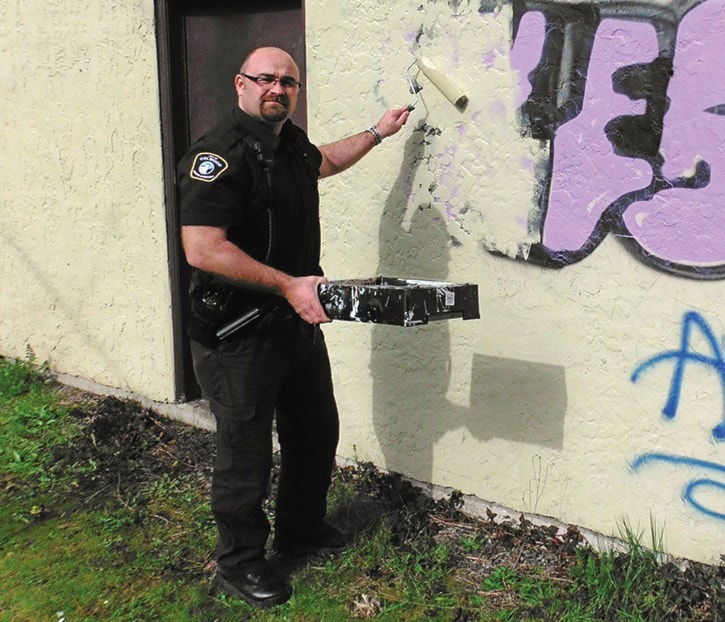The problem of graffiti surfacing on the West Shore has seen a dramatic reduction, according to bylaw enforcement officials from Langford and Colwood.
Despite a couple of recent acts of vandalism at Ruth King elementary and on the Millstream overpass, the number of incidents in Langford has been dropping for the past five years, said City of Langford bylaw officer Paul Lambert. He cited increasing fines from $100 to $500 per graffiti tag as one reason, adding one youth was recently fined $1,500 for three tags in different locations. “Another deterrent is our efforts to cover up graffiti as soon as it surfaces,” he said.
Bylaw officers carry spray that covers the damage until further repairs can be done, if required.
The Millstream overpass tagging was handled by bylaw enforcement officers, who were tipped off by RCMP after police received calls from passing motorists. “They were able to catch them red-handed before the RCMP arrived,” Lambert said. Langford has added two bylaw officers for 2016 to increase bike and vehicle patrols during the day and night.
Fellow Langford bylaw officer Brad Batter cites regular meetings with police and other agencies throughout the Capital Region and communities up Island as also helping.
“The offenders tend to move around,” he said. “Broad-based information sharing really helps in that regard. Without the proper resources and co-operation between agencies, I think we’d be back to where we were years ago.”
Lorne Fletcher, manager of community safety and enforcement for Langford, said the city took a strong approach to dealing with the problem in 2008. The city took the parents of a prolific young offender to court to recover the cost of extensive graffiti damage in a case that was settled in 2011.
“We got calls from across Canada from solicitors representing cities (after the court settlement) asking for details about the case,” Fletcher said. “It was significant, because the parents were held responsible for the actions of their son.”
The city received $10,000 for damage to public property and $1,000 to repair damage to private property. In addition, terms included a $2,000 donation to the Goldstream Food Bank, 100 hours of community service and an order for the offender to take counselling.
Coun. Lillian Szpak, chair of Langford’s protective services committee, agreed co-operation between agencies is key. “Council has taken a very proactive approach to dealing with damage to public and private property,” she said. “The significant reduction we’re seeing indicates we’re clearly on the right path.”
Colwood bylaw officer Phil Williams said graffiti in Colwood is at a five-year low, with an overall reduction of 92 per cent of tags since 2011.
“We’re very pleased with the results. It’s been a watershed year, the first year we haven’t had to fine anyone,” he said. “Sharing of information with other agencies is paramount in reducing the damage from graffiti.” According to a recent report, the cost of graffiti removal was $5,435 in 2015, compared to $35,000 in 2012. That’s a significant reduction considering millions of dollars a year are spent battling graffiti throughout the Capital Region, Williams noted.
Colwood ran 20 offenders through its alternate disposition program between 2012 and 2015. The program aims to deter offenders through fines, education and community service, which is typically spent repairing damage or picking up litter. An agreement with BC Hydro provides Colwood with $1,000 a year for graffiti removal supplies. Williams also credits Rona Home and Garden Centre for donating rollers, trays and paint brushes, further reducing costs.
reporter@goldstreamgazette.com
